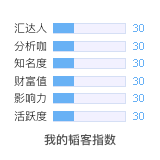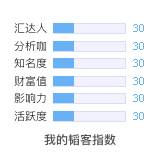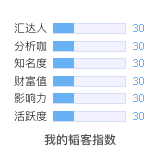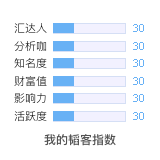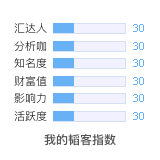查看:29296回复:94
[Sharkeater]介绍一种交易策略:
“The Triple Screen Approach”
++++++++++++++++++++++++++++++++++++++
“The Triple Screen Approach” 是一种交易策略, 他的作者是Alexander
Elder, 是一个职业交易员和持照心理学家, 曾经担任过金融交易论坛公司的主管。 它的核心是将在不同时间或时期内,市场上存在的三种势, 大势, 中势, 和小势区别对待,以赢取可能的最大的利润。
它不同于很多其他交易技术和策略的风格,明确地提出在交易时断以当时的主导势为侧重,对我们加深对主次矛盾的区分,大小势的对待,合理的安排和制定交易策略, 有着很好的启示。
作为一种方法和交易策略的推荐,并不是一定要大家去仿照,而主要目的是让大家开拓眼界,从中吸取适应你自己消化的养分。
文章是英文,全文以原文给出, 为了避免任意加上推荐者本人的观点而使原作者的作品走样。l38论坛的北方一狼协助给出了翻译,在此一并致谢。
+++++++++++++++++++++++++++++++++++++++++
2楼
Those positive features in many trading techniques can also lead to dangerous losses when market conditions change.
Even the most widely accepted techniques ------ "The trend is your friend," "Buy (or sell) breakouts" and "Buy lows, sell high" ----- can be costly. It's like running an obstacle course, where being 6 feet tall may be an advantage in running on a straightaway but won't help when you have to crawl through a 10-inch tube.
So how can you resolve the contradinctory advice provided by normally sound trading techniques? In discussing trading approaches, you first need to be clear which trends and breakouts you are trying to catch. Trading weekly, daily or hourly trends calls for different techniques.
To be successful, you have to combine several trading techniques, selected so their negative features can cancel out each other while their positive features stay undisturbed. The secret is to apply each technique to a different time frame of market events.
Robert Rhea, the great market technician of the 1930s, compared the three market trends -- major, intermediate and minor --- to a tide, a wave, and a ripple. Most traders, especially those who cannot follow intraday moves, can benefit from intermediate trends, which last from two weeks to two months. You want to ride the wave (intermediate move) while taking advantage of the tide and letting even the ripple run in your favor.
That is the goal of the triple screen system, which uses three consecutive screens, or tests, before entering any trade. Each test uses a different trading approach. Many trades that seem attractive at first are rejected by one or another screen. Those potential trades that pass the triple screen tests have a high degree of profitability.
make money and make fun
3楼
当盘市风向改变时,很多平时屡试不爽的交易策略也会归于失效。
一些广为人知的交易方法,诸如“顺势而为”、“突破后下单”“高抛低吸”等等,这时反可能会给投资者带来损失。如同障碍赛跑一样,6英尺高的身材在直道赛跑中会优势尽占,但于穿越10英尺长管道障碍时,身材的高大反有撤肘之虞。那么该如何看待平时功勋累累,此时却无力回天的矛盾呢?
在讨论交易策略时,你首先要清楚的是你要跟的是哪一个势或突破方向。交易周期有异,相应的交易策略则大相径庭。
为求成功,你需要结合分析多种交易方式,选取适应面广的那些----既可以随时作出调整,又不致因调整而使优势失去。关键在于:使所选取的操盘策略能尽可能多地适用于不同的行情。
罗伯特•;里亚,是一位二十世纪三十年代知名的技术分析师。他将汇市的长、中、短三个时期,分别比作大浪、中浪和涟漪。大多数的投资者,虽不易得益于一日的行情变化,但完全可受惠在中期的波动中------无非需要耐心等待两周或者两个月而已。你需要的是:在驾驭中浪时,充分利用大浪之势,而忽略那些微波涟漪。
这便是汇市“三段论”的分析要旨,在入市交易前一定要将此三者综合考虑。每一种尝试都有不同的操作策略,而许多最终被摒弃的策略,在最初只置于单段着眼时,似乎是那样的诱人。只有那些通过汇市“三段论”考量的交易策略,才能撷取最大的利润。
make money and make fun
4楼
Screen I: CATCHING THE TIDE
You first goal is to identify the major trend, the market's tide. Start by examining weekly charts. The longer-term perspective puts you a jump ahead of those who watch only dily charts --- with everybody looking at the same few months of data.
You can use several techniques to find the weekly trend. Trendlines and channels are useful. so are moving averages, whixh smooth week-to-week fluctuations.
Many favorite indicator of the major trend on weekly charts is moving average convergence divergence (MACD), originally developed by Gerald Appel. It is sophisticated system of three exponential moving averages on closing prices.
The weekly chart of Treasury bond futures has MACD plotted underneath the prices, both as exponential moving average lines and as a histogram(Fig. 11.1, --- will give at a seperated post). The lines show crossovers between faster and slower exponential moving averages while the histogram tracks the difference between the two lines.
The histogram that keeps growing in either a positive or negative direction indicates growing bullish or bearish sentiment and forecasts a turn in market direction, frequently in advance of the price reversal. MACD line crossovers come later and issue decisive buy and sell signals.
The first "screen" (market test) before entering a trade involves finding the direction of the weekly MACD histogram. If it is rising (bullish), take only long positions. If it is falling (bearish), only trade short. Always trade in the direction of the market tide.
18楼
第一段:把握大浪
第一要务是判定"大势"---即汇海中所谓的“大浪”,此宜从周线图入手----图表的周期愈长,就愈能使你的视野跳出繁枝缛节,从而提前预知,进而把握住大势。
但是,面对同一张月图------放眼于月间大势者少,而只识眼前波动者多。
判别周趋势有多条途径:利用“趋势线”和“通道”技术行之有效;运用“移动平均线”技术,也有着异曲同工之妙,其波形平滑而稳定-------以“周”为计量单位使然。
“平滑移动平均线”(MACD),是同类技术中出类拨萃的分析指标,由杰拉德•;;阿贝尔首创。在与收盘数据相关的三大技术指标中,其可靠性已久经考验。
在周线图的下方,MACD图与之同步并行,并与移动平均线和柱状图交相辉映。 这些线显示了快、慢速平均移动指数的交叉位置,而柱状图却记录了这两条线的不同之处。
柱状图的攀升不息或下跌不止,真实地反映出牛市的亢奋和熊市的低靡;在行情反转前,也常会伴有前期的征兆。随后,MACD线的交叉也会接踵而来,买(卖)信号便由此发出。
入市的第一阶段(检验市场)。在进入一次交易之前,应潜心于寻找周MACD指标柱状图的运行方向。如果它是上升的(牛市),只能开立多头部位。如果它是下降的(熊市),则只能做空。
记住,不要轻易逆着“大浪”弄潮。
[此帖子已被 白羽 在 2004-9-16 15:41:57 编辑过]
make money and make fun
15楼
Screen II: RIDING THE WAVE
After finding the weekly trend, switch to daily charts and indicators for the second screen to identify the intermidiate trend. Look for daily moves against the weekly trend.
For this screen, use oscillators with dailycharts instead of trend indicators. Their rapid fluctuations between positive and negative extremes help you locate temporarily overbought or oversold ocnditions (that means the market has moved too far up or too far down and is likely to snap back).
While the first screen put you in a trend-following mode, you now want to go countertrend ---- "buy low, sell high." That can be dangerous, but now youcan use it with confidence because buy and sell signals from daily oscillators make logical sense. When the market tide is coming in (weekly MACD rises), every pause and wave that goes against the tide ---- shorter countertrend moves ----offers an opportunity to get aboard the trend. It is probable that the weekly trend will reassert itself, leading to profits.
It would be dangerous to rely on oscillators alone. In major downtrends, they can go into an oversold mode and stay there for weeks at a time, hurting a premature buyer. But, when the weekly trend is upward, you can use negative readings of a daily oscillator to get ready to buy. When the weekly trend is down, use positive readings of a daily oscillator to get ready to sell short.
One daily indicator that does a good job of identifying intermediate daily reactions against weekly trends is the Stochastic indicator, developed by George Lane. Stochastics track the positioning of daily closing prices within the daily range.
Closing prices tend to accumulate toward the tops of the ranges in advance of upside reversals of downtrends and toward the bottoms in advance of downside reversals of uptrends. The raw data is smoothed and represented by two lines, one faster, the other slower. You derive buy-sell signals when the faster line acrosses above or below the slower line.
There are other methods fo rinterpreting Stochastics, but this one serves our purpose. The chart shows how crossovers by the faster line of the five-day Stochastic above the slower line have given good buy signals while the weekly MACD was in an uptrend.
make money and make fun
16楼
第二:驾驭中浪
在发现周趋势后,接着便转入对日图及其指标的研究,以判定中期趋势,并在研究日运行规律的同时与周趋势相对照。
对此阶段的分析,宜充分利用日图的振荡特性,而非趋向指标。掌握其上下界间快速波动的规律,会有助于准确捕捉超买、超卖的瞬间(此刻意味着市场向一方移动过量,有回调要求)。
在第一阶段里,操盘的关键应是顺大势而为。当时若仍一味坚持“高抛低吸”,反有不合时宜之嫌,属逆市操作,相当危险。
而现在,你却可放心使用,因为买卖信号在日振荡中往往颇有规律。当大浪将至(周MACD指标上行),中途每一次短暂的调整或与大浪走势相逆的一刻,都是介入的良机,周浪会再掀波澜-------赢利可期了。
但是,若仅依赖震荡去操作,亦不甚保险。多数的跌势中,它们会进入超卖状态,甚至僵持一周之久,很容易对初出茅庐的新手形成误导,造成伤害。但是,当趋势一旦转而向上,你自可重操旧业----借日震荡之便,卖出空头。
相对于周趋势而言,判定中期日趋势之另一利器为随机指数,其创始人是乔治•;雷恩。该指数的主要研究对象为日波动区间内的收盘价。
收盘价在由跌转涨前趋于向上沿靠拢;而在自涨返跌前则趋于向下沿渐近。原始数据信息由两条一快一慢的平滑曲线为代表。买卖信号基于两点,即K线对D线是上穿还是下破。
行情预测之法虽各有神通,但下述方法亦行之有效:当图表显示5日随机数的快线上穿慢线时买入信号发出;反之,则为明确的卖出信号。
make money and make fun
19楼
Screen 3 Reading the Ripple
The thisd screen uses intraday trends to help you enter positions. When the weekly trend is up, you want to buy each time the daily countertrend pushes price down. But you also want to protect yourself from the danger that the countertrends may continue even lower.
The third screen helps you benenfit from the buying opportunities while protecting you from the risk that the brief downtrend may turn into a major one. In major downtrends,it helps you benefit from shorting into the countertrend rallies while protecting you from the risk that those rallies will become bullish reversals.
This screen consists of using trailing stop techniques (not to be confused with stop-loss orders). A trailing buy-stop order trails above the previous day's range on the way down,angling for the upside reversal. A trailing sell-stop order trails below the previous day's range on the way up to catch a renewed downturn.
If the daily oscillator goes negative on Tuesday while the weekly trend is up, then place a buy order, good for Wednesday only, above Tuesday's high. If the weekly trend pushes back up, as you expect, you will be "stopped in," automatically buying a short-term breakout from the intermediate downtrend.
If prices continue lower on Wednesday, you remain out of the market. You lose nothing, but the buy signal remains ineffect as long as the oscillator remains in negative territory. Then,. on Thursday you place a buy order, good for one day only, above the Wednesday high. you continue this procedure until you are either "stopped in " on an upside reversal or a bearish trend is signaled by the weekly MACD, canceling the buy signal.
This buy-stop technique is reversed to a sell-stop technique for shorting when the weekly trend is down but th edaily oscillators rally into positive territory.
to be continued
make money and make fun
17楼
第三阶段:解读“涟漪”
第三阶段的主旨为:通过研究日趋势判定入仓位:当周趋势向上途中,在根据日图逢低买入的同时,又要注意避免续跌的损失。
本阶段的关键是:如何既减少小跌转入大跌时的操盘风险,又能从中渔利;而在大势真正转跌后,又可在作空中二次获利,同时有效控制大跌中出现小涨时所带来的风险。
本阶段使用“盘停下单”技术(区别于“止损”技术)。
其内容有两方面:一为“跌停作多”技术,即在跌势中对前一交易日盘价分析后,伺机于小势反弹前的停顿点作多;二为“涨停作空”技术,即类似地,在涨势中对前一交易日的盘价分析后,伺机于返跌前的停顿点作空。
当周趋势向多,而周二的日震荡却偏下时,可逢低买入----但只适用于周三行情,可较周二高位再看高一线。此后,若周趋势一如预期又重新向上,则可寻一回调突破点介入,建立中期跌势里搏反弹的短线仓位。
若盘价在周三续跌,就宜离场观望,此时保住既得利润为第一要务。如果买入信号持续存在,周四可再度下单,但只对当天价位有效,并可看高于周三高位。
“盘停下单”操作,可反复使用,直至周图出现明显的反转信号时,方可取消。
与“跌停作多”技术同理,而可反其道用之的则是“涨停作空”技术,即当周趋势向下,而日震荡却向上时,可逢高作空。
(未完待续)
《综述》及《坚持设止损》
make money and make fun
20楼
THREE SCREEN SUMMARY
Thus, the triple screen system consists of three consecutive screens or tests, each applied before entering any market position:
1. Identify the major trend, using a MACD histogram on weekly charts.
2, Identify the intermediate daily trend running counter to the major trend. Use short-term oscillators, such as force index, Stochastic or Williams'%R. When the weekly MACD is bullish, watch for daily oscillotor declines. When the weekly MACD is bearish, watch for daily oscillotor rallies.
3, When the weekly trend is up and the daily oscillator is negative, use a trailing buy-stop technique to enter or add long positions. When the weekly trend is down and the daily osicllator is positive, use a trailing sell-stop tehcnique to enter or add short positions.
MAINTAINING A STOP
Using stop-loss and protect-profit orders is essential in trading futures. After the triple screen system gives you a buy signal and you go long using the trailing buy-stop technique, your new stop-loss level becomes the low of the day you went long or the low of the previous day, whichever is lower. That low will rarely be violated because you are trading in the direction of the market tide. Reverse the procedure in downtrends. This gives you tight protection with relatively low dollar risk.
Conservative traders should buy or sell on the first signal from the triple screen system and stay with those positions until the weekly rend reverses or until stopped out. Aggressive traders can use renewed buy or sell signals from the triple screen system for pyramiding or adding to the original positions.
The End
make money and make fun
21楼
第三阶段:综述
综前所述,汇市行情被划分成的三个阶段,互相关联,共同组成一有机整体。每建一仓都应逐条参照:
1. 利用周图中MACD柱状图判明大趋势。
2. 参照主趋势,找出与之相逆的日趋势,再利用测定短期振荡幅度的指标,如:力度指数、随机指数或威廉指标等。当周图向多时,要对日图振荡下行行情充分注意;而当周图转空时,则应对日图盘价的震荡上扬,予以充分关注。
3. 当周趋势向上而日震荡相反时,应用“跌停作多”原则择机入仓;而当周趋势向下,日震荡偏上时,则宜考虑按“涨停作空”原则逢高作空。
常设止损
对交易而方,设 “止损”或“止蠃”位实为立仓之本。按“三段论”所示的入仓信号,并以“盘停下单”原则择机下单后,止损价应定为当日与前日盘价中之最低位。该低点被突破的可能性甚小----大浪之势使然。从而以较低的成本风险保住了既得利益。
稳健的持盘者会依据“三段论”所示,于买入信号首次出现时果断下单,并坚持持有,直至周势终结或止损出局;而激进的投资者可以金字塔方式分批入仓,或原位多次加仓。
make money and make fun
27楼
ATTACCHING A FIGURE AS REFERENCE FOR DIGESTING
 [此帖子已被 sharkeater 在 2004-9-17 11:45:01 编辑过]
[此帖子已被 sharkeater 在 2004-9-17 11:45:01 编辑过]
 [此帖子已被 sharkeater 在 2004-9-17 11:45:01 编辑过]
[此帖子已被 sharkeater 在 2004-9-17 11:45:01 编辑过]make money and make fun
发表于:2004-09-17 03:51只看该作者
26楼
好,大多数散户停留在"涟漪"上...当然原因多多...
[em16] [em16]
22楼
原文由 [B]zsb[/B] 发表: 好,大多数散户停留在"涟漪"上...当然原因多多... [em16] [em16]
make money and make fun
发表于:2004-09-17 04:22只看该作者
23楼
理论和实际相结合,总不甚完美。
韬客社区www.talkfx.co
发表于:2004-09-27 11:30只看该作者
8楼
[em43] [em43] [em43] [em43] [em43] [em43] [em43] [em43]
发表于:2004-09-28 01:26只看该作者
28楼
沙老师运用的工具都是模糊数学系的,拿数浪来说吧,仁者见仁,智者见智,你数的是5浪,我看象8浪,具体低于多少幅度不算浪,新手很难分辨。数学里的曲线形状定了,方程式就有了,曲线每一点的座标就定了。外汇的曲线无形无式,随机性很大,主要靠经念。平面座标里的运动规迹是今天以前发生的,以后的涨跌概率各50%,日元每年9月都是跌的,那跌的可能又多了几成,但不是必然规律,也许机缘凑巧,明年的9月涨了。模糊数学用必然规律不是老师所倡导的一分为二的唯物主义的观点。
发表于:2004-09-28 04:24只看该作者
5楼
[em15] [em15]
韬客社区www.talkfx.co











